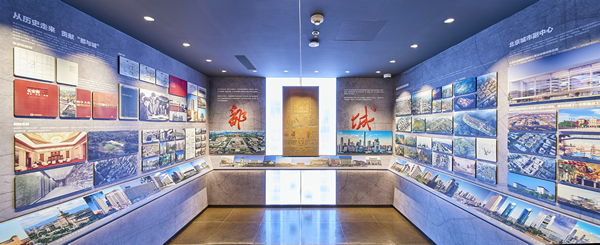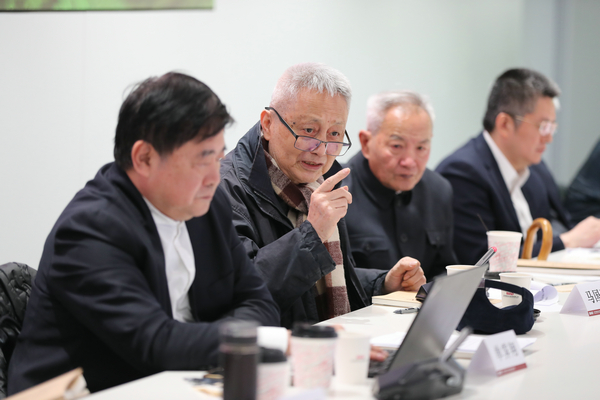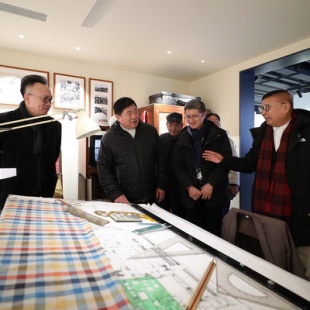New museum records firm's contribution to country's architecture


A quick stroll through the newly opened history museum of Beijing Institute of Architectural Design Co., Ltd (BIAD) is nothing short of a roller-coaster of surprise and marvel.
Visitors can find themselves gasping in admiration while viewing displays showcasing the institute's illustrious achievements, ranging from the majestic architectural complexes on Tian'anmen Square and those along Chang'an Avenue to numerous landmarks such as airports, stadiums, museums, theaters, and multinational headquarters that characterize Beijing's skyline, and to a medley of overseas projects such as the Lusail Stadium which hosted the FIFA World Cup Qatar 2022.
Established in the same year when the People's Republic of China was founded, BIAD is the country's first architectural design institute. It is home to one Chinese Academy of Engineering academician, 16 National Engineering Survey and Design Masters, and countless great architects dedicated to China's architectural development.
"We created the history museum to commemorate our 75 years of extraordinary journey. The display records each of our footsteps since 1949, mirroring the changes of times through the perspective of an architecture firm," said Zhang Yu, general manager of BIAD, in his opening remarks at the symposium.
Curated by Ma Guoxin, chief architect at BIAD and an academician at the Chinese Academy of Engineering, the museum's exhibition is framed by two clues — one showing the institute's significant events year by year since its inception and the other its representative works located in more than 50 countries around the world.
A room dubbed "the Crystal Palace" highlights the exhibit. It reenacted the office scene when BIAD architects were busy designing the Great Hall of the People in the 1950s. On view is an architect's workstation featuring a draft, rulers, a lamp, an abacus, and furniture of that period.
"Residents nearby nicknamed the BIAD building the Crystal Palace because its offices were always bright when our architects worked round the clock to design eight of the Ten Great Buildings to celebrate China's tenth birthday," Zhang said.
The ten public buildings completed in 1959 to commemorate the tenth anniversary of the founding of PRC are the Great Hall of the People, the Cultural Palace of Nationalities, the Diaoyutai State Guesthouse, the China Revolutionary History Museum (today's National Museum of China), the Workers' Stadium, the Overseas Chinese Hotel, the Minzu Hotel, the Chinese People's Revolutionary Military Museum, the Beijing Railway Station, and the National Agriculture Exhibition Hall. BIAD architects designed the first eight.

Another highlight of the show is the room titled "The Capital and Beijing," showcasing the firm's deep ties with Beijing's urban planning to fulfill its role as the country's capital. In this room, visitors can learn about all the significant projects masterminded by the BIAD architects along the city's Chang'an Avenue and Central Axis and those on Tian'anmen Square.
A symposium, themed on BIAD's new history museum, was held on Monday, where dozens of architects and experts of cultural relics and museology shared their personal experiences with the architecture firm.
"In China, it is none other than BIAD which has designed the most public architecture projects of national importance since the founding of PRC," said Shan Jixiang, president of the Chinese Society of Cultural Relics and former director of the Palace Museum.
"It's crucial to have such a museum which records the institute's brilliant history and, in particular, commemorates with photos and videos all those outstanding architects who devoted themselves to building our country and the capital city, thus imbuing their works with spirit and culture," he added.
"The history museum of BIAD is also a museum presenting the history of the architectural development of New China in the 20th century," remarked Li Cundong, secretary-general of the Architectural Society of China.
Apart from recognizing BIAD's outstanding contribution to designing Beijing as China's capital, symposium participants also commended BIAD's efforts in promoting Chinese architecture culture.
"As early as in the 1990s, BIAD created the magazine ArchiCreation, which compiled the seven-volume Sixty Years of Chinese Architecture: 1949-2009 in celebrating the 60th anniversary of the founding of PRC. It's a book of great social influence and academic value," said senior architect Bu Zhengwei.
Bu also noted that Ma Guoxin represented Chinese architects in submitting the list of China's 20th-century architectural heritage to the International Union of Architects in 2004.
"This has greatly encouraged the architectural community to explore, research, and promote China's architectural heritage, and it has also opened up a new field in the new era to popularize China's excellent architectural culture among the general public," Bu remarked.

Ma has spent his entire career working at BIAD and designed the Chairman Mao Memorial Hall in Tian'anmen Square, the National Olympic Sports Center, and Terminal 2 of the Beijing Capital International Airport.
The renowned architect and academician also heads the committee on 20th-century architectural heritage affiliated with the Chinese Cultural Relics Society.
Since 2014, the Chinese Society of Cultural Relics and the Architectural Society of China have been working closely to survey and identify China's 20th-century architectural masterpieces, keeping up-to-date with the international trend in protecting the architectural heritage created in the last century.
The two academic bodies have jointly published eight batches of Chinese 20th-century architectural heritage sites, a total of 798 items, ranging from theaters, hotels, and restaurants to school campuses and transportation facilities.
Many BIAD-designed projects were recognized as part of Chinese 20th-century architectural heritage.
Symposium attendees also suggested that BIAD hold regular public open days for its history museum and produce new media content, such as short videos, to satisfy young people's thirst for architecture and history.





































